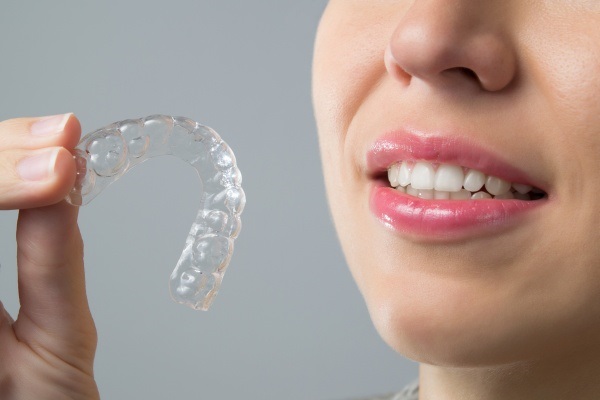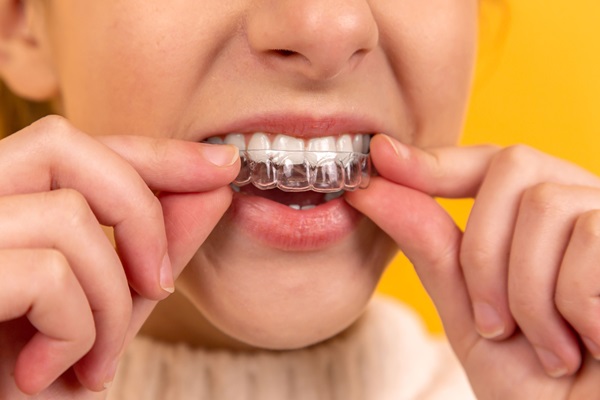What Happens During an Invisalign® Appointment?

If you are reading this article, you are already considering getting Invisalign treatments. This article will cover everything you need to know about these clear aligners and what treatment entails.
Invisalign is a brand of clear aligners that give patients a less conspicuous way to deal with their teeth alignment problems. It consists of using clear trays to push teeth into a better position over a period of time. Patients get a number of trays at the start of treatment and each pushes the person's teeth 0.33 millimeters closer to the desired alignment. It is then switched out with another tray that pushes the person's teeth closer to the final position.
It can be used to address issues like an incorrect bite, crooked or misaligned teeth. Such bite alignment problems can lead to a variety of unpleasant symptoms like:
- Soreness
- Headaches
- Snoring
- Unhealthy gums
- Jaw pain
- Worn down teeth
- Tooth decay
What to expect during an Invisalign appointment
Here are the various steps patients who are interested in orthodontic treatments with Invisalign should expect:
1. A consultation
During the first visit, the dentist will discuss how the treatment works. They will take an impression and pictures of the patient's mouth. These pictures are used to make a better analysis of their teeth structure.
If the dentist feels the patient is a good candidate for Invisalign, digital imaging technology is used to make an impression of the patient's mouth. It leads to more accurate scans that can be immediately transmitted to an Invisalign lab. It takes about three weeks for the lab to make the aligners and get them back to the dentist.
2. Testing the aligners
During the second appointment, the patient gets to test out their first set of aligners. They will also have attachments added to their teeth. These attachments help to hold the aligners tightly on teeth. It creates holds and pushes for natural movements that occur while the device is being worn. There is no pain during the procedure and the materials used are tooth-colored, making attachments hard to detect. Attachments can be removed later, and they cause no damage to teeth.
A procedure called interproximal reduction might be performed for the same reason. It involves sanding parts of some teeth to create room for the aligners. The procedure is not painful but it does involve the use of anesthetics. The patient will be given their set of aligner trays if everything looks good.
3. Treatment
Once the patient gets their aligner trays, it is their responsibility to wear them for at least 22 hours each day. Aligners should only be taken out for meals or oral hygiene.
The patient will be scheduled for follow-up appointments to monitor their progress. During these appointments, changes might be made to the attachments or more trays added to the treatment.
4. Finishing treatment
Once the patient has gone through the treatment, the dentist will evaluate their results. If satisfied, attachments will be removed and the patient is switched to retainers. These help to keep their teeth in their new position.
Treatment has never been more subtle
Thanks to Invisalign, you can fix orthodontic issues without having to wear metal braces that look like railroad tracks on your teeth. Stop by our Long Grove office to get started with your treatment.
Here's how you reach us…
Request an appointment here: https://www.longgrovedental.com or call Long Grove Dental at (847) 636-5020 for an appointment in our Long Grove office.
Check out what others are saying about our services on Yelp: Read our Yelp reviews.
Recent Posts
Minor chips, cracks, and gaps in the smile do not have to be permanent. Dental bonding is a quick yet durable way to repair teeth with these cosmetic imperfections. With natural-looking results and minimal preparation, bonding can support oral health and restore the smile to its prior radiance.Dental bonding is a cosmetic procedure in which…
Clear aligners are a great way to straighten misaligned teeth and achieve a better smile overall, but there are other orthodontic treatment options which are worth considering as well. One of the hardest decision for those who want teeth straightening treatment is determining which option is best, and having more information about clear aligners can…
Although X-rays in general dentistry have been used for ages, digital X-rays are proving to be more efficient and safer. They offer numerous benefits that traditional ones do not, making them more popular among general dentistry practices. Here is what you can expect from the use of digital X-rays in general dentistry.Outlined below are some…
A beautiful smile boosts self-confidence and leaves a lasting impression. porcelain veneers are a popular cosmetic solution, covering the front of teeth to correct discoloration, chips, and minor misalignments. Thus, they provide a transformative balance of beauty and function. Understanding the benefits of porcelain veneers can help you decide whether they are the right choice…


